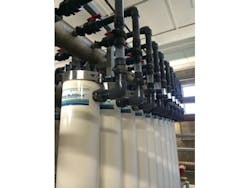Reaching a Higher Standard
In 2003, the City of Butler, Mo., placed its new water treatment facility into service, producing drinking water from a surface water impoundment. The 3-mgd plant serves the city’s customers and four other public water supply districts. The system consists of coagulation, clarification/settling, pH adjustment, oxidation, preliminary filtration, ultrafiltration (UF) and disinfection. In addition to meeting primary drinking water standards, the system effluent was required to have turbidity levels below 0.3 ntu on a monthly average. To make sure these conditions could be met, the system was required to undergo a periodic direct integrity test (DIT) that is intended to identify damaged or broken membrane fibers.
The Problem
Over time, DIT failures steadily increased as membrane fibers broke or pulled away from their potting. This resulted in more and more frequent fiber repair and the eventual replacement of the membrane modules with the original brand. The integrity problems persisted until, in early 2013, it was determined that the best course of action was to replace the modules with those using more-robust fibers. When consulted, the original membrane manufacturer noted that it had an improved membrane, but that the new modules would not easily retrofit into the existing racks.
In addition, the Missouri Department of Natural Resources (MDNR) informed the city that starting in October 2014, treatment would have to meet the Long Term 2 (LT2) Enhanced Surface Water Treatment Rule that had recently been enacted by the U.S. Environmental Protection Agency. This rule requires that the plant demonstrate 99.99% (4-log) removal of Cryptosporidium cysts, as verified through both a daily DIT and continuous indirect integrity testing (turbidity monitoring).
The Solution
As a result, in June 2013, the city decided to replace the membranes with Aqua MultiBore membranes from Aqua-Aerobic Systems due to the strength of the fiber’s honeycomb-like construction.
After discussions with the MDNR, the city’s consultant engineer proposed to the state a pilot study wherein the modules on one of the plant’s four ultrafiltration (UF) trains would be replaced and operated for nine months to verify their ability to meet the LT2 rule. The MDNR approved the proposal, and the modules were purchased, installed and started up in April 2014.
The Results
Since startup, the system has passed the daily DITs, effluent turbidities have been averaging less than 0.03 ntu and specific fluxes have consistently been above 20 gfd/psi, over 30% higher than the other three trains. As a result, the city has now purchased Aqua MultiBore membrane modules for the remaining three trains.
